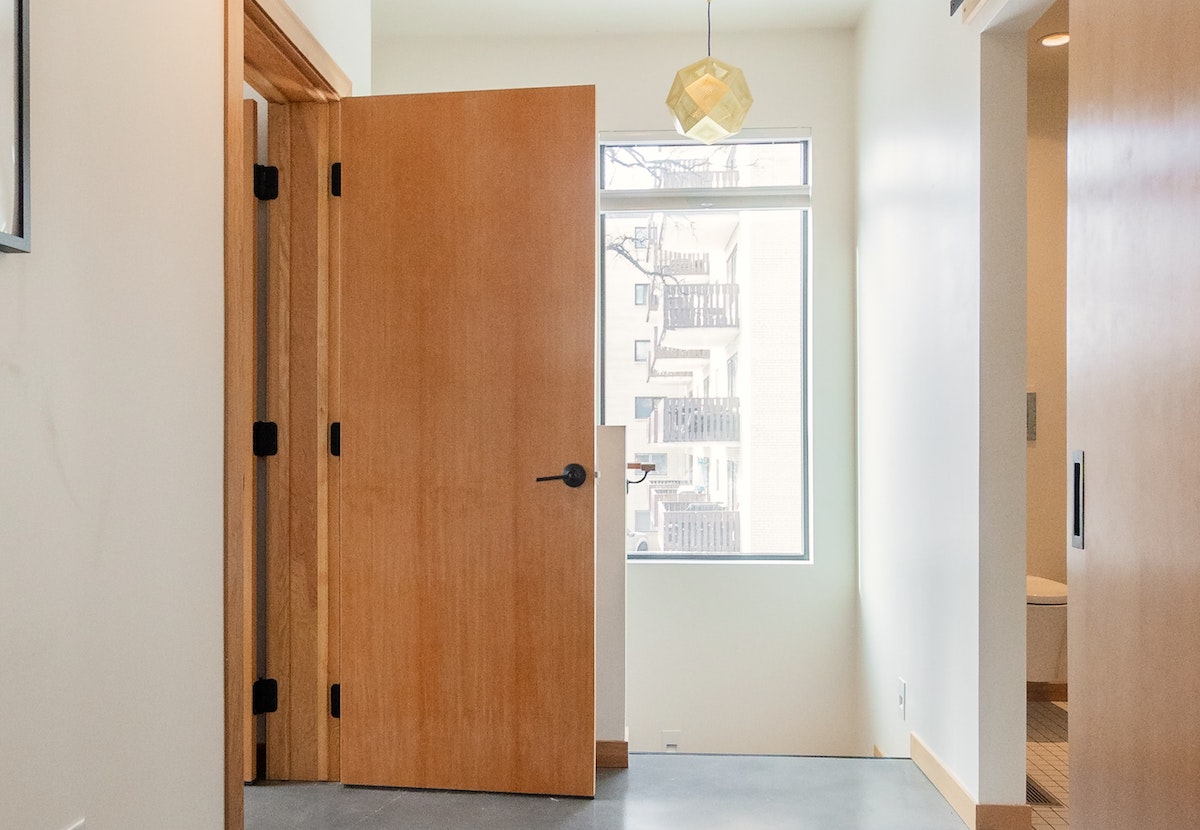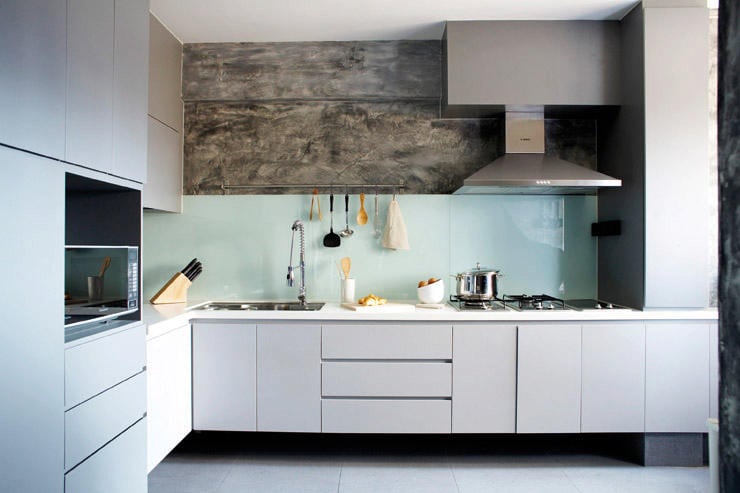
Even though it’s still a relatively unfamiliar term to the mass, veneer dates back to ancient Egyptian times. Because the wood was a limited commodity, the archaic people saw it into thin slices to make the most of the little material available.
Fast forward to the 20th century, and veneer production became a mechanized process fully-adapted to the modern woodworking and door-making industry. Nowadays, it’s regular for manufacturers to come up with thinner and more delicate slices of all types of veneers.
11 Best Veneer Door Companies In Singapore (Our Top Picks)
Companies | Services | Address | Ratings |
Homees Concierge Service | Homees Concierge Service Team - tell us what you need and we'll help get it solved. Talk to us today by giving us a call or Whatsapp us now. | 994 Bendemeer #03-04 Singapore 339943 | Average Rating: 5/5 |
AT Aliminium | - Window Grill Installation | 39 Woodlands Close #01-16 Mega@Woodlands Singapore 737856 | Average Rating: 5/5 |
Yong Fang | - Timber Door | 48 Toh Guan Road East #02-114 Enterprise Hub Singapore 608586 | Average Rating: 5/5 |
SG Doors | - Door Installation | 5 Sungei Kadut Ave Singapore 729642 | Average Rating: 5/5 |
Laminate Door | - HDB Gate Replacement | Tradehub 21, 18 Boon Lay Way, #03-133 Singapore 609966 | Average Rating: 5/5 |
Your Digital Lock | - Door Installation | Link @ Ang Mo Kio #05-33 Singapore 569139 | Average Rating: 5/5 |
HDDoor Pte Ltd | - Sliding Door Installation - Renovation Contractors | 11 Woodlands Close, #06-06/05 Woodlands 1 Singapore 737853 | Average Rating: 5/5 |
Siong Door | - Door Hardware | 1072 Eunos Avenue 5 #01-170 Singapore 409751 | Average Rating: 5/5 |
Goodhill Doors | - HDB Gate Replacement | 9 Sungei Kadut Street 5 Singapore 728956 | |
Central Aluminium & Glass Construction | - Metal Gates Installation | 132 Woodlands Industrial Park E5 Singapore 757853 | |
Good Wood Doors & Joinery Works | - Door Hardware | Block 6 Lorong 8 Toa Payoh Industrial Park #01-1305 Singapore 319058 | |
Wee Ping Aluminium Contractor | - Door Installation | Tampines North Drive 1 #07-23 T-Space Singapore 528559 |
Hire Veneer Door Services In Singapore
View All Veneer Door Companies
What is a veneer door?
Usually, veneer refers to the thin slices of wood or bark on a door surface. As a standard, the process consists of glueing one or multiple layers onto core panels. These cores usually use wood, chipboard, or MDF.
Moreover, there’s veneer plywood too. Perhaps, this material employs three or more layers of veneer. The difference is in the 90-degree gluing that adds to the strength of the material. Also, there’s veneer beading that serves a more decorative purpose.
How is the Veneer made?
Generally, the process of veneer ply production involves peeling the trunk of a tree. Still, some manufacturers do it by slicing the material into large rectangular blocks known as flitches. The process consists of cutting the wood under a particular angle so that the final product has enhanced grain and figure appearance.
Furthermore, there are different types of making veneer. Rotary lathe, half-round lathe, and slicing machine are the three most popular methods for commercial production. Each of them gives a different result.
For instance, a rotary lathe peels off the wood in one continuous or semi-continuous roll. Because the cut is concentric on the growth rings, it doesn’t have many appealing properties.
With a slicing machine, the result is more desirable. In contrast, the typical process involves raising and lowering a piece of log against a blade. The method yields a “crown cut” veneer that’s a lot similar to parts of wood cut across the rings.
Perhaps, the most delicate veneer-making equipment, the half-round lathe uses a log or a piece of lumber that allows for smooth operation with the most valuable parts of the grain. The result is a highly-textured wood ply, often referred to as a “rift cut” veneer.
How is Wood Veneer manufactured?
Usually, veneer producers get hold of the high-quality logs for two main reasons – higher profit and more usable wood.
One of the advantages of wood veneer manufacture is that unlike solid lumber, veneers come in thin pieces – 0.6 mm in the least.
The process allows for minimal waste of material, known as the “saw kerf”. As a result, the yield is much higher, and the stress on the resource is lesser.
To further enhance its efficiency, some manufacturers have implemented a knife to “slice off” the slim pieces so that there’s no waste of wood at all.
Moreover, it’s a common practice to keep the slices in numerical order so that customers can buy them in a package.
What are the different types of wood veneer?
Apart from the conventional “flat cut” and “quarter cut” classification, there are about 200 species of woods that are available as veneers.
Depending on the preferences, they fall into several generalized categories: Natural and composite surface, backed and unbacked veneer faces, sequenced or numbered panels, pre-finished veneer, and other speciality veneers (moisture-resistant, fire-retardant, bendable, etc.). Here’s a more detailed view of the most popular types of layers:
Raw veneer
As the name suggests, this veneer has no backing. This feature allows for the free use of either side. Moreover, they will appear different once you apply a finish because of the wood cell structure.
Veneer with paper backing
This type of coating has a paper backing. One of the advantages is that they come in large sheets, which eliminates the need to join smaller pieces together. Besides, it reduces the risk of cracks and seasonal expansion and contraction caused by changes in humidity.
Veneer with phenolic backing
In general, a phenolic-backed veneer door is a rare sight. However, this material is becoming more popular due to the concern for natural resources. The artificial wood veneer also comes in large sheets.
Laid up veneer
If you’re a DIY enthusiast, you can try your luck with a laid-up veneer door. The material is a simple combination of a few raw veneer pieces.
Reconstituted veneer
Usually, this kind of veneer comes from fast-growing tropical trees. Creating a veneer door from a reconstituted veneer involves taking hard coating and dying the sheets. Then, the manufacturer laminates the layers together into a block. Lastly, they slice the edges of the laminated surface to create grain.
Wood-on-wood veneer
Also known as two-ply veneer, wood on wood is a beautiful face employing two wood veneers by bonding them together. The original grain is usually adjacent to the backer veneer.
The “crossband construction” allows moderate bending. The backside often uses hardwood of lesser value because its only purpose is to provide protection against bubbling caused by improper bonding.
What are the advantages of veneer doors?
Affordable Aesthetics
As mentioned previously, the best thing about wood veneers is that they provide a look identical to the original wood. On top of that, it’s quite inexpensive. The thin slice of wood is an easy solution to any engineered wood substrate to achieve real wood-like appeal.
Versatility
Another great advantage of wood veneer is that it can come in virtually any wood. Moreover, each layer within a tree log is different, so there’s an enormous selection that will satisfy any customer taste.
The natural veneer can undergo customization with various polish or varnish for an exclusive dark look that adds to the uniformity and the timeless look of any home interior.
Enhanced Durability
Unlike MDF and HDF, wood veneer sheets provide incredible robustness and durability when applied to weak engineered woods. For example, fiberboards are highly susceptible to damage from moisture and water.
At the same time, the wood veneer is warp and fragmentation-resistant. Besides, natural material lasts much longer than laminates. Just make sure you keep the surface off water to avoid damaging its polish.
Environmentally Friendly
Another benefit of using wood veneers is that it’s eco-friendly. It’s a sustainable way of implementing a natural wood product into furniture and doors not only because of the minimal use of material but also because it’s easy-to-recycle. The end product is a common ingredient in the making of particleboard and MDF.
Wood Utilization
As part of the environmentally-friendly plan of mimicking wood with little or no pure material at all, wood veneer provides an excellent product to waste ratio. A tree log can produce numerous veneer sheets, and manufacturers can efficiently utilize them as coverings for various pieces of furniture.
Non-toxicity
Last but not least, the sole fact that wood veneers come from a natural source is enough to guarantee that there are no toxic substances in their structure. Moreover, the non-toxic adhesives available in the furniture-making industry ensure that wood veneers won’t emit VOCs after applying them to the substrates.
What are the cons of wood veneers?
Prone to Water Damage
As mentioned above, lumber veneers are very hardy but still prone to water exposure. The only way to deal with the danger of exposing your veneer door is to apply a sealant on the surface.
Difficult Installation
Unlike laminates, veneer sheets are challenging to install and require skilled professionals. They know how to cope with the air gaps. This element is vital for a perfect finish.
Also, the plies need acclimatization before the installation.
Maintenance
If you shy away from the idea of having to clean your furniture, doors, and windows at home regularly, then reconsider buying wood veneer products. Still, they’re relatively easy to maintain, but you’ll have to polish your wood veneer doorway periodically for optimal durability.
No Repairs
Another major disadvantage of veneers is that they are unmendable. Solid wood is natural to repair, and all you’ll need is some sanding. On the opposite, a thin veneer sheet isn’t subject to repair. Also, MDF and plywood do not expand or contract. On the contrary, a wood veneer that serves as a surface for such cores changes its size according to the climate changes, which sometimes causes formation cracks.
Where can you use a veneer door?
A veneer door works as a seamless substitute for the far more expensive wooden door. Therefore, it’s suitable for both interior and exterior applications. Depending on your preferences, you can apply different types of wood veneers to achieve an expensive and stylish look.
Is veneer better than solid wood?
Contrary to popular belief, veneer doesn’t step down from natural wood. Perhaps, the only difference between a veneer door and a solid wood door is the core. That’s why it’s safe to say that a veneer door is an inexpensive alternative to solid wood. Commonly, the best furniture and door pieces combine the best of both worlds. The results are often stylish and genuine-looking wooden pieces with exotic veneer surfaces.
What are the typical veneer substrates?
Usually, you’d see veneer as a surface for real wood. It’s the most attractive option on the market even though it might not be stable like plywood. On the other hand, plywood incorporates thin laminates of wood in various layers adjacent to each other for extra stability and strength.
If you’re looking for plywood veneer furniture, go for at least nine layers. Medium-density fiberboard, also known as MDF, employs powdered wood sheets glued to each other. The base provides easy workability at affordable prices, which makes it ideal for the purpose. Another similar alternative is chipboard.
How to choose the best wood door?
Every renovation or interior design project requires an investment, even for the smallest changes in furniture, doors, or windows. No matter how much money you have prepared, you’d always want to get the best value for your money.
Surely, you’ll get a high-quality piece of furniture or door, and it will last for at least 10 to 15 years. But if you take the risk and splurge on the most exquisite option, you’ll have a servant that will last a lifetime.
Therefore, you should always be well-aware of the factors that can affect quality. Besides, being ready to spend a little more will pay off big time in the long term.
When it comes to doors, lots of homeowners have a hard time picking a model. The abundance of considerations often confuses, especially for those who like to shop online.
Of course, it’s much better to touch, push, and pull the product before purchasing it. Just as important as the looks, it’s also vital to know about the core of the door. All in all, it’s essential to be better prepared on the matter to make the best choice for your home renovation.
What’s the difference between solid wood, engineered wood, and veneer?
Wood has long been a staple in interior design. The classic appeal of the different types of lumber is unmatchable – one of the main reasons why wood is still a preferred material for doors. Unfortunately, its price often makes it quite unaffordable.
For this reason, lots of manufacturers offer alternative options that mimic the original but at a significantly lower cost. In recent years, buyers often have to choose between two main categories of wood doors – solid or engineered wood. To learn more about each type of timber entryway, here’s a more in-depth look at the matter.
Solid Wood Door
Firstly, these doors are the crown piece of woodwork. Typically, such a door employs one solid piece of wood or multiple pieces glued together. Due to their outstanding aesthetic properties, solid wood doors can be rather expensive for the average customer.
Engineered Wood Doors
A far more affordable alternative to solid wood, engineered doors consist of internal pieces of lumber with a more costly outer layer, known as veneer. This layer makes the product look like real hardwood, thus giving the door a far more upscale feel.
The most popular version of engineered wood is perhaps the chipboard core, which consists of tiny lumber fragments glued together. Some manufacturers also use MDF, but no matter what, a 0.6-0.9 mm layer of thick veneer can give any engineered wood door the look of solid timber.
Last but not least, engineered doors provide excellent value for their money not only because of the lower price but also because of their durability. Such doors can withstand bowing or twisting, and most of all, you can have that exotic veneer front layer and still save money. That’s why combining engineered core with a veneer surface is the golden mean for a statement wood door.
Solid wood, Engineered wood, or Veneer doors – Which to choose?
Generally, most retailers and customers would assume that solid wood is the best option because it’s merely natural. Contrary to popular belief, there are some aspects in which engineered wood performs just as good as its prototype. On top of that, in some cases, the former might perform even better.
Cost
By now, it should be clear that solid wood is considerably more expensive than its rival. The reason is apparent – such doors usually use single pieces of pricy hardwood species, such as oak.
Since they require a considerable amount of the particular tree, it’s easy to understand why an engineered door is so affordable. These doors require only a few millimetres of hardwood for the outer layer. Moreover, they make use of the otherwise unusable parts of the tree, like smaller branches or knots.
Performance
In terms of performance, the results with veneered doors are very fluctuating. For instance, if the manufacturer hasn’t applied the veneer properly, it’s evident that the door will display some flaws after a few months of operation.
The formed bubbles will eventually create difficult-to-remove blemishes that require the use of iron or a razor blade. Of course, with a careful approach, such a doorway will look just as stylish as its solid wood counterpart.
On top of that, you won’t have to worry about warping, which often occurs in solid timber doorways. The leading cause of warping is the fluctuations in temperature and moisture levels, which cause expansions and contractions, thus changing the shape of the door piece.
Eventually, you might have to deal with a door that catches and sticks. Luckily, you can protect your solid wood surface by applying a coat of wax or polish.
Since engineered wood employs a broader range of tree species, the outcome shows generally better consistency. Of course, nothing can compare to the natural warmth and charm of solid wood, but engineered and veneered doors don’t fall behind.
Efficiency
Perhaps, the ability to preserve the indoor temperature is critical in choosing a door, especially if it’s an external one. For this reason, it’s good to account this two elements – the convective heat transfer (the U-value) and the thermal insulation (the R-value). Warping is often a problem, and even the smallest difference on the sides of a door can ruin the entire process of thermal insulation.
In such cases, a water-resistant proofed engineered door can be quite handy. The structure facilitates materials running in different directions, which ensures evenly distributed stress through the layers. Furthermore, the different planks will eliminate the warping to make for a door with a consistent shape.
Ultimately, modern types of engineered doors will provide slightly better energy efficiency than real wood, making them a preferable choice for front and external doors.
Manipulation
Unfortunately, there is one major drawback with engineered and veneered doors. The installation itself isn’t that big of a problem. The real issue occurs when it’s time to treat it or attempt to remove chips.
Because the outer veneer is so thin, it’s nearly impossible to smooth it. This issue often opts for a thicker layer of veneer on the sides, known as lipping. Usually ranging anywhere from a few millimetres to a few centimetres, this feature allows for slight adjustment of the door if needed.
On the opposite, a solid wood door provides a consistent and sturdy surface that requires no lipping. You can easily adjust it on both the sides and face of the door. Besides, you can fix the outer layer without worrying about reaching the core.
Cost of Other Home Improvement Areas
You can check out the cost of hiring professionals for other aspects of your home improvement project. Some of the general cost guides can be found below:
We’re here to improve your home
Speak to hundreds of reliable pros, view their gallery, inspirations, and know the best prices with our resources.
Have full control over your home improvement projects with Homees.





